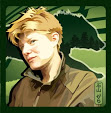It isn't dark here all the time, just to get that out of the way. ;) But it DOES get dark in the winter.
It's just like anywhere else in the world that is a significant distance from the equator. As winter approaches in the northern hemisphere, the earth tilts AWAY from the sun on its axis. This makes the sun appear lower on the horizon. The further from the equator you go in the winter, the shorter the days will be. The opposite is true for summer, though, and people tend to forget that. As summer approaches, the earth tilts toward the sun and we get more sunlight; the sun appears higher in the sky, and the days grow longer.
But it's not just a half-and-half jump. (You wouldn't BELIEVE how many people think this). It's a gradual thing.
Ok. Anchorage is the closest place to me on this sunlight chart - the daylight hours are a bit different for Palmer because we're surrounded by mountains. Fairbanks is a little less than halfway up the body of the state heading north, and Barrow is the farthest town North in the US. But you get the idea of the angle affecting hours of light from this chart:
Maximum Daylight Hrs. at Summer Solstice (June 20 or 21)
Anchorage
Sunrise - 3:21am
Sunset - 10:42pm
Hrs. of daylight - 19:21hrs
Fairbanks
Sunrise - 1:59am
Sunset - 11:48pm
Hrs. of daylight - 21:49
Barrow
Sunrise - May 10
Sunset - Aug 2
Hrs. of daylight - continuous
Yes. So the sun literally goes in circles around the sky in Barrow. You can get photos of this, timelapse. Now for the darker days..
Minimum Daylight Hours at Winter Solstice (Dec. 21 or 22)
Anchorage
Sunrise - 10:14am
Sunset - 3:42pm
Hrs. of daylight - 5:28
Fairbanks
Sunrise - 10:59am
Sunset - 2:41pm
Hrs. daylight - 3:42
Barrow
The sun sets November 18th and does not rise until January 24 for a period of 67 days in which there is NO daylight in Barrow.
The boundary for this is the Arctic Circle. Starting at this level of lattitude, there is one day where the sun does not set in the summer. From there north, the amount of days with Midnight Sun increases. Fairbanks isn't far from the Arctic Circle, so they get a lot of daylight.
And even though the sun goes below the horizon in the summer, it doesn't get DARK. It's kind of dusky. In some places, it's still bright enough to read without straining your eyes or anything. Geography has a lot to do with it - mountains to the north of you will make it darker out, but for the most part, anyplace north of Anchorage doesn't ever get DARK out in the middle of summer.
As for winter, that's another thing. The sun doesn't technically RISE in Palmer til even later because the mountains are so tall and they're RIGHT there. And closer to Solstice, the sun barely scrapes along the tops of the mountains to the south, even going behind Pioneer Peak if you're in town. Today I noticed that the sun is about a hand's width above the same mountains in the middle of the day now. Certainly seems cheerier with the increased amount of light.
Funny, because it used to not really bother me. Or maybe I just never noticed. Or maybe I've been too busy in the past to let the lack of light depress me or something. One thing's for sure, in the winter with the sun so low on the horizon, you get KILLER sunsets and sunrises ALL the time. :D
This may all seem completely fascinating to folks who have never thought about it before. Equally it might seem totally logial and not that interesting. I choose to enjoy and relish the little things like this that are around me daily - it enriches my surroundings and makes the universe seem that much more special and interesting. It's fun to mark how much daylight we've got and it adds to the uniqueness of each season. Some people complain about the amount of darkness in the winter but personally I find it cozy and magical, just as I find the summer daylight envigorating.
Just my three bingles' worth.
Sunday, February 20, 2005
Subscribe to:
Post Comments (Atom)

No comments:
Post a Comment